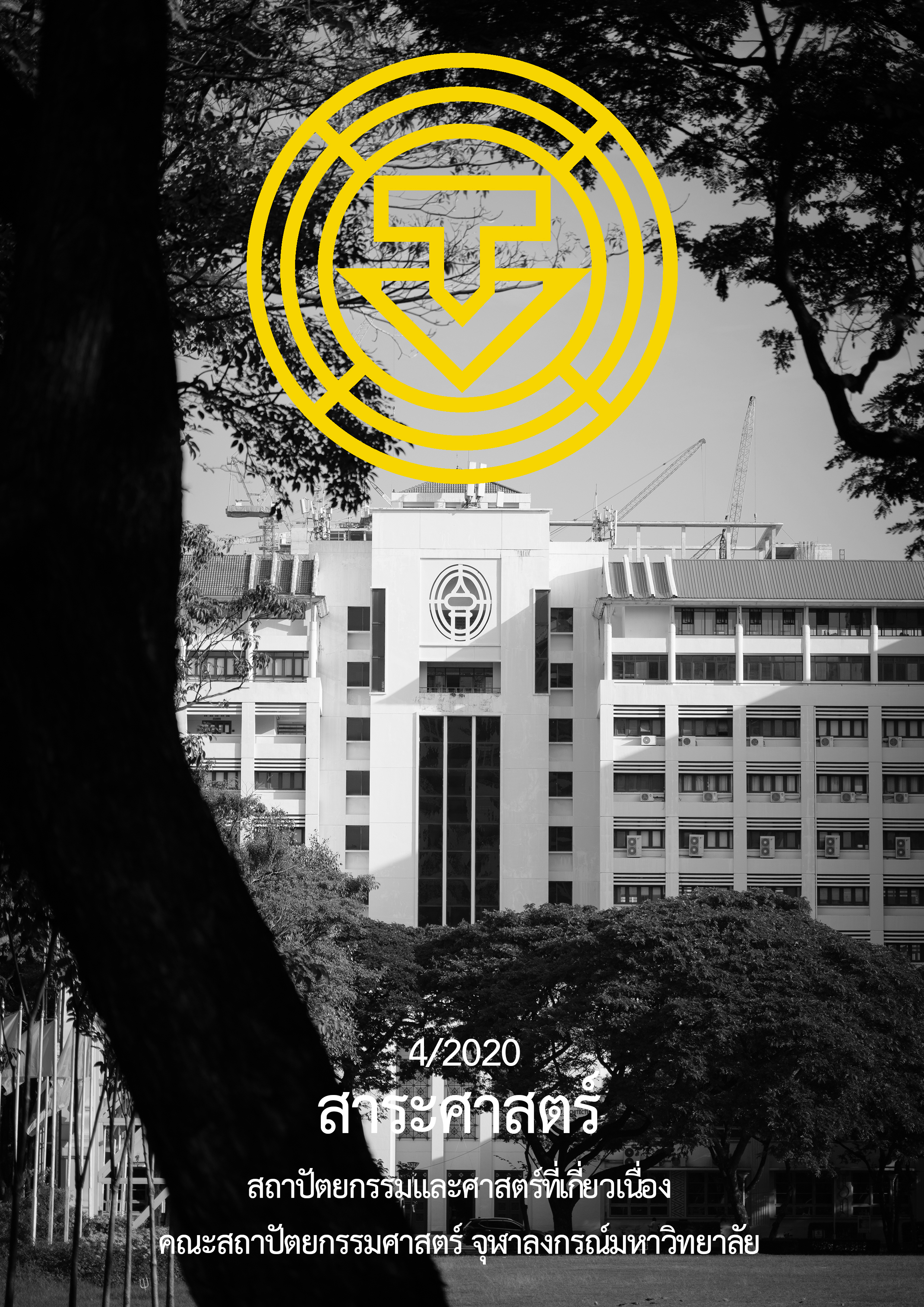การนำ Bertaud Model มาใช้ในการจัดทำโครงการที่อยู่อาศัยในประเทศไทย
Main Article Content
บทคัดย่อ
Bertaud model คือแบบจำลองการคำนวณวิเคราะห์โครงการเบื้องต้น เป็นเครื่องมือในการพัฒนาการออกแบบวางผัง พร้อมกับการวิเคราะห์การเงินโครงการ ทั้งในโครงการที่อยู่อาศัยระดับชุมชนและโครงการระดับเมือง ในปีค.ศ. 1977 (พ.ศ. 2520) Alain Bertaud ผู้พัฒนาแบบจำลองนี้ และที่ปรึกษาการพัฒนาเมืองจากธนาคารโลกได้นำแบบจำลองเวอร์ชั่นแรกมาใช้ในการเคหะแห่งชาติประเทศไทยเป็นที่แรก พร้อมกับการนำใช้แนวคิด Site and Services ในการออกแบบวางผังและวิเคราะห์โครงการเคหะชุมชนทุ่งสองห้องเป็นโครงการนำร่อง ต่อมาภายหลัง สุพัฒน์ ลอยเดือนฉาย บุคลากรของการเคหะฯ ได้พัฒนาแบบจำลองให้ใช้งานด้วย Microsoft Excel ประเทศไทยจึงมีส่วนสำคัญในการพัฒนา Bertaud model
จากการทบทวนวรรณกรรมพบว่า Bertaud model ถูกนำไปใช้อย่างกว้างขวางในกลุ่มนักวางแผนพัฒนาโครงการที่อยู่อาศัยสำหรับผู้มีรายได้น้อย และโครงการพัฒนาเมืองทั้งในภาครัฐและภาคเอกชน อย่างน้อยใน 25 ประเทศ โดยนักวางแผนอย่างน้อย 74 คน ทั่วโลก เช่น การใช้เพื่อวิเคราะห์และแก้ไขข้อกำหนดมาตรฐานที่อยู่อาศัย SLCHP (Special Low Cost Housing Program) ของประเทศมาเลเซีย และการใช้วิเคราะห์การออกแบบวางผังและการเงินโครงการที่อยู่อาศัยผู้มีรายได้น้อยของการเคหะแห่งชาติประเทศไทย เป็นต้น ในปีพ.ศ. 2557 หลักสูตรเคหพัฒนศาสตร์มหาบัณฑิต ภาควิชาเคหการ คณะสถาปัตยกรรมศาสตร์ จุฬาลงกรณ์มหาวิทยาลัย มีการนำ Bertaud model เวอร์ชั่นที่การเคหะแห่งชาติพัฒนาขึ้นมาเป็นส่วนหนึ่งในการเรียนการสอน พบว่าแบบจำลองนี้มีประโยชน์มากในการศึกษาความเป็นไปได้เบื้องต้นของโครงการพัฒนาที่อยู่อาศัยแนวราบ แต่ยังมีข้อจำกัดในการนำมาใช้ศึกษาความเป็นไปได้เบื้องต้นสำหรับโครงการที่อยู่อาศัยประเภทอาคารสูง
ผลการศึกษาการนำ Bertaud model มาใช้ในการจัดทำโครงการที่อยู่อาศัยในประเทศไทย แสดงให้เห็นว่า แบบจำลองนี้มีประโยชน์ต่อทั้งภาครัฐ ภาคเอกชน ภาควิชาการ และการผังเมือง นอกจากแบบจำลองจะสามารถใช้วิเคราะห์การออกแบบวางผังในระดับโครงการแล้ว ยังสามารถใช้ในระดับนโยบาย และยังเป็นเครื่องมือให้เกิดการเปลี่ยนแปลงกระบวนการออกแบบวางผังให้มีประสิทธิภาพยิ่งขึ้น แบบจำลองนี้มีศักยภาพพัฒนาในการใช้สำหรับโครงการผสมผสานการใช้ประโยชน์ (mixed - use) ประเภทอาคารสูงได้ โดยควรมีการทำคู่มือการใช้งาน Bertaud model และการเพิ่มมิติด้านสังคม
Article Details
เอกสารอ้างอิง
การเคหะแห่งชาติ. (2531). รายงานประจำปี 2530-2531. เข้าถึงได้จาก www.nha.co.th>view>รายงานประจำปี
การเคหะแห่งชาติ. (2018). พิพิธภัณฑ์เสมือนการเรียนรู้ด้านการพัฒนาที่อยู่อาศัย. สืบค้นจาก http://housingvm.nha.co.th /index.html
กำหนดรายการมาตรฐานที่อยู่อาศัยและสิ่งแวดล้อม. (2533). เข้าถึงได้จาก https://drive.google.com/file/d/1JWlBCLI3D5kY-YtUVKu1tgiTwC-zWmA1/view?usp=sharing
โชติรัตน์ สว่างวงษ์, กุณฑลทิพย พานิชภักดิ์ และ ภานินี ชยานันท์. (2563). การเปรียบเทียบต้นทุนและผลตอบแทนโครงการจัดสรรในประเทศไทยโดยการใช้เบอร์โทด์โมเดล: กรณีศึกษา หมู่บ้านจัดสรรในอำเภอธัญบุรี จังหวัดปทุมธานี. กรุงเทพฯ: ภาควิชาเคหการ คณะสถาปัตยกรรมศาสตร์ จุฬาลงกรณ์มหาวิทยาลัย.
ปานทิพย์ อมตวรกุล. อดีตผู้อำนวยการฝ่ายวิชาการพัฒนาที่อยู่อาศัย การเคหะแห่งชาติ. 27 พฤศจิกายน 2562. สัมภาษณ์.
ภาวิณี ธีรสวัสดิ์. อดีตรองผู้ว่าการการเคหะแห่งชาติ. 16 มิถุนายน 2562. สัมภาษณ์.
รายการสนทนากับไทเลอร์. เข้าถึงได้จาก http://medium.com/conversations-with-tyler-cowen-alain-bertaud-cities urbanism-3321136c71d8
Alain, B. (2013). Alain Bertaud’s blog. Retrieved 2020, January 13, from http://alainbertaud.com/
Alain, B. (2019). Alain Bertaud on cities, markets, and people (ep. 76 — live in NYC). Retrieved 2020, March 25, from https://medium.com/conversations-with-tyler/tyler-cowen-alain-bertaud-cities-urbanism-3321136c71d8
Alain, B., & Mapezzi, S. (2001). Measuring the costs and benefits of urban land use regulation: A simple model with an application to Malaysia. Journal of Housing Economics, 10(3), 393-418. DOI: 10.1006/jhec.2001.0293
Alain, B., Marie-Agnes, B., & James O. Wright, Jr. (1988). Efficiency in land use and infrastructure design an application of the Bertaud model. Washington, DC: The World Bank.
Bulloch, B. & Sullivan, J. (2010). Information – The key to the real estate development process. Retrieved 2020, March 13, from Cornell Real Estate Review https://hd/.handle.neF/1813/70677
McCormick, K., Richter, J. L., & Pantzar, M. (2015). Greening the economy compendium. Retrieved 2020, May 18, from Lund University https://lup.lub.lu.se/search/ws/files/7509153/201604_Course_Compendium.pdf
Malpezzi, S. (2017). Getting housing inclusive right: A classic case study from Malaysia. Retrieved 2020, August 5, from http://reudviewpoint.blogspot.com/2017/
Pedro Ferraz de, A. (1993). The Bertaud model: A two-way mirror on the evolution of information technology’s impact on planning for low-income housing. Retrieved 2019, April 24, from Massachusettes Institute of Technology www.labtec.cs.net>docs>PEA_Bertaud-FVP_ICSA4-GR.pdf
Thailand Staff Project Report Bangkok Sites and Services and Slum Improvement Project. (1978). Retrieved 2020, March 25, from The World Bank https://documents.worldbank.org/en/publication/documents reports/documentdetail/623471468173357502/thailand-bangkok-sites-and-services-and-slum-improvement project


